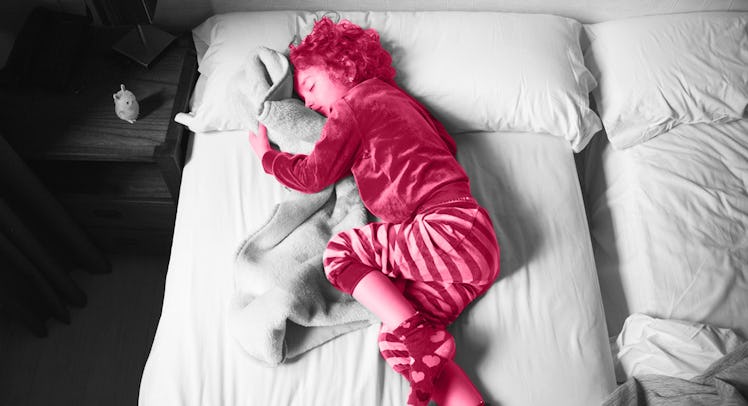Signs Your Kid Has A Sleep Disorder
It’s worrisome when your kid struggles to get the sleep they need. Here’s how to tell if it’s a phase or a sleep disorder.

You may be used to tossing and turning during the night, especially after a stressful day at work. But when your child is wide-awake at 1 a.m., it’s natural to feel concerned. How can you tell if it’s just a stage she’s going through, or whether it’s a more serious problem? Start with these indications of a childhood sleep disorder.
1. Gasping and Irregular Breathing
The most common sleep disorder in kids is called sleep apnea, affecting between one and four percent of the pediatric population, according to the American Sleep Apnea Association. What’s more, some studies suggest that up to 25 percent of kids suffering from ADHD may also have sleep apnea. “This is characterized by snoring, pauses in breathing, or gasping during sleep,” says Lisa Meltzer, Ph.D., associate professor of pediatrics and National Jewish Health in Denver, Colorado.
2. Uncontrollable Twitching
A common sleep disorder in both kids and adults, restless leg syndrome is identifiable by the uncontrollable need to move one’s legs while resting. It generally occurs at bedtime or during sleep, and disappears during the day when the leg muscles are active. “Kids will describe it as this itchy sensation,” says Meltzer. “Parents frequently mistake it for growing pains, but its origins are different.” Although there is no cure for restless leg syndrome, you can ease the discomfort by helping your child get out of bed and walk up and down the hall a few times.
3. Early Night Awakening
“For kids ages four to eight, this is the time for night terrors,” says Meltzer. Considered a behavioral sleep disorder, kids who suffer from night terrors awaken early during the sleep cycle, frequently screaming. “You’ll walk into their room and they are sitting up in bed screaming and no matter what a parent says, they can’t be consoled,” says Meltzer. “It’s as if your child is looking right through you, and it can be quite scary.” The good news is that night terrors end as quickly as they come on, and your child will soon lie back down to sleep as if nothing has happened. “The events are usually benign and kids will grow out of them as they get older,” Meltzer adds.
4. Late Night Awakening
Unlike night terrors, nightmares usually occur in the last third of the night. Some kids will call out for their parents, while others may patter down the hall for solace. “This is an age when the imagination is rampant, which leads to fears as kids are challenged to distinguish between what’s a dream and what’s reality,” says Meltzer. Like night terrors, the condition typically subsides over time (although even adults still get occasional nightmares), and you shouldn’t worry about it unless it’s a nightly occurrence.
5. Refusing to Sleep
Unlike insomnia, which is characterized by an actual inability to fall asleep, in the case of sleep fear, a child willfully resists the urge to rest for fear that something will “get him” during the night. The behavioral condition occurs most often in preschoolers and early grade schoolers, who have trouble distinguishing between real and make-believe. Trying to console your child can feel like an exercise in futility, but Meltzer knows a trick. “In this age group, monster spray is a parent’s best friend,” she says. “Fill a spray bottle with water, and give it to your child, explaining that this special spray is filled with stuff that monsters are allergic to. When you spray it in the air, they can’t come close or they will start sneezing uncontrollably.” If only all of life’s troubles could be solved so easily.
This article was originally published on